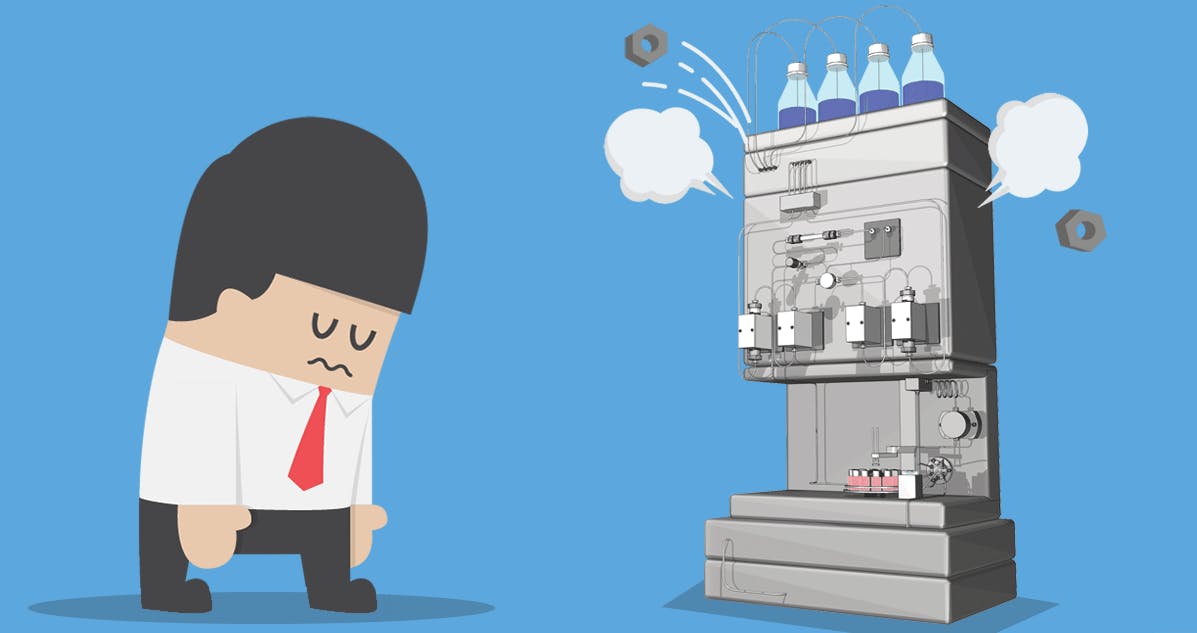
"Time is money" and an instrument costs money, even if it is not used. Your customers pay for accurate and fast results, but if your instrument does not generate them, revenue will be lost. Add to this the fact that power supplies, environmental controls, gas supply and laboratory space are costs that continue to accumulate when the instrument is offline. This means that it is crucial for any analytical laboratory to keep an instrument in perfect condition, and preventive maintenance is always preferable to unplanned maintenance.
Preventive maintenance keeps chromatography instruments in optimal condition and reduces unplanned downtimes that always take more time for the performance. So, what are the basic ways to make your instrument happy?
Get to know your system!
How many times has a user shown a "problem" chromatogram and the puzzle piece is to figure out what the real problem is? How can you determine if there is definitely a problem that needs to be solved?!
Look, listen and feel your system. You can see how buffer crystallizes from leaks, cracks in the hose, damage to fittings. You can hear if your degasser is having problems or if a turbopump is having problems. You can feel when your rough pump does not turn on or when a column is not connected properly.
By far the best way to prove that there is a problem is to run a known sample with a known method that will give you a basic chromatogram for comparison. You can use the recorded chromatogram if you know that the instrument is working correctly and see what differences there are in the same sample / method that was just performed. Have retention times shifted globally or just for a single peak? Is the noise louder? Are the tip shapes correct? Are the tune parameters read back to similar levels?
Many laboratories routinely do this by adding control samples and system suitability test samples (SST), which verify that the system is functioning and optimized during the analysis runs so that the generated data is valid. If you take the time to see if maintenance is needed before shutting down or narrowing down the focus of the investigation, the lab will stay up and running.


Figure 1 - An example of overlapping SST, showing the global shift in retention time.
Keep good records!
Everyone has a "bob" in his laboratory — the person who is the longest in the company and performs all the maintenance of the instruments. Everyone goes to Bob when there is a problem. But what happens to the "Bob jobs" when Bob is not there?
Keeping good records of maintenance performed and sample types analyzed on the system allows anyone to start troubleshooting and/or maintenance. Records can also be used to determine if trends occur in the maintenance performed — for example, that filters are clogged more often than they should, indicating inappropriate sample / mobile phase preparation. Whatever the problem, proactive steps can be taken. Complete records can also reveal potential future requirements - for example, if the detector voltages increase rapidly.


Figure 2 - Example of an HPLC service protocol.
Garbage in, garbage out
Think of your analysis as a recipe for a meal. Fresh, clean ingredients (samples and mobile phase) are always a much better foundation, and a little seasoning (buffer, pH) improves the taste (data quality) dramatically. Of course, if you are in a hurry, you can always use yesterday's leftovers when you check them first to make sure they do no harm. Just don't expect it to taste so good!
Clean pots and pans ensure that the flavors of the previous meal (sample procrastination) are removed, and subsequent washing ensures that they remain in the right condition for the next cook.
All this means that the quality of the material you enter into the system, and the system itself will determine the quality of the final data. The more time you spend on preparation, the less time you spend on cleaning instruments and chromatograms. There are many ways to achieve this, including techniques such as SPE, shared injections and solvent cleaning.


Figure 3 - Example of an aqueous mobile phase that has not been prepared correctly.
To touch
It is said that adults generally absorb about 20% of what they read / hear, but 80% of what they personally experience. So there is no substitute for getting your hands a little dirty and taking an instrument apart (if necessary!). Therefore, if you are careful, they are unlikely to cause damage, which means that you will not have to rely on annual PMs to keep an instrument in good condition. Schematics and written instructions are good for preparation, but it lacks the realism of practical experience.
A basic understanding of the theory is also invaluable for keeping an instrument in perfect order. For example, if you understand how important the widening of the bands is for the quality of chromatography, then you are well aware of the choice and condition of the sample loop, the connecting tube and the injection volumes.
Many users see instruments as big gray boxes and are intimidated by their operation and thus their maintenance needs. A few fundamental changes to your approach can demystify the process and improve the performance of your lab, which not only saves time and money, but also reduces analyst stress!

